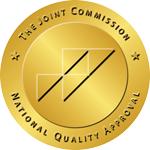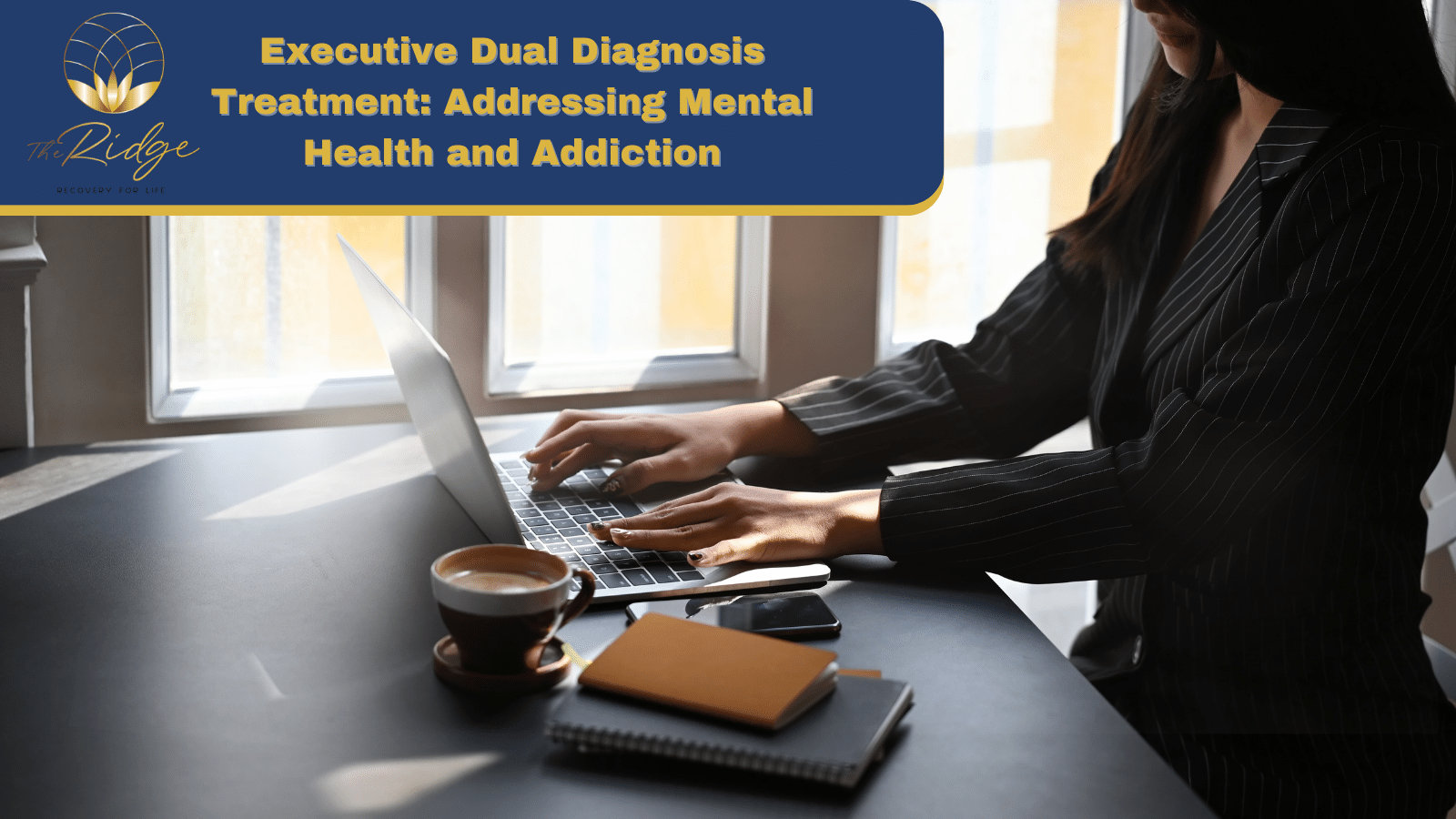Balancing life and a top-professional role can be challenging, especially for executives managing high-ranking people, tasks, and responsibilities. This often leads to a host of mental health challenges that make both professional and personal life difficult and unfulfilling.
Beyond the mental health challenges, executives with a mental health disorder are more vulnerable to developing a substance use disorder, and vice versa. Research has shown that people with mental health disorders are more likely to have a substance use disorder compared to the general population, making executives more prone to co-occurring disorders.
Executive dual diagnosis treatment offers tailored and comprehensive support for executives facing the challenges of both a substance use disorder and underlying mental health issues.
What is Dual Diagnosis in Addiction Treatment?
Dual diagnosis in addiction treatment is the coexistence of a substance use disorder (SUD) and a mental health disorder in an individual. It is also commonly known as co-occurring disorder or comorbidity. Dual diagnosis recognizes that substance abuse and mental health issues often occur together and can have complex interactions.
When someone has a dual diagnosis, they may be struggling with conditions such as depression, schizophrenia, anxiety, bipolar disorder, or post-traumatic stress disorder (PTSD) alongside their addiction. Both substance use disorder and mental health disorders are considered primary and interconnected conditions that require comprehensive treatment.
Dual diagnosis can be challenging to diagnose and treat because the symptoms of addiction and mental health disorders can overlap and influence each other. Substance abuse can exacerbate mental health symptoms, and mental health disorders can increase the risk of developing substance abuse problems as individuals may turn to drugs or alcohol as a way to cope with their symptoms.
The goal of dual diagnosis treatment for executives is to support individuals in achieving and maintaining recovery from both the substance use disorder and the mental health disorder. By addressing both conditions concurrently, individuals have a better chance of long-term success and improved overall well-being.
How Common is Dual Diagnosis?
Dual diagnosis is relatively common, with high rates of co-occurrence between substance use disorders and mental health disorders. According to the Substance Abuse and Mental Health Services Administration (SAMHSA), in the United States, approximately 9.2 million adults had a co-occurring mental illness and substance use disorder in 2019.
What are the Symptoms of Co-occurring Disorders?
The symptoms of dual diagnosis (co-occurring disorders) can vary widely depending on the specific condition and individual. This is because different genetic, physical, relationship, and work-related factors influence co-occurring disorders in different people. The symptoms can include:
- Feeling persistently sad and losing interest in activities
- Excessive worrying and feeling restless
- Extreme mood swings, ranging from high energy to sadness
- Having flashbacks, intrusive thoughts, and trouble sleeping after a traumatic event
- Having unwanted thoughts or fears and performing repetitive behaviors to reduce anxiety
- Sudden and intense fear or discomfort, accompanied by physical symptoms
- Feeling extreme fear or anxiety in social situations and avoiding them
- Experiencing delusions, hallucinations, and difficulties with thinking and emotions
- Having intense mood swings, unstable self-image, and problems with relationships
- Trouble paying attention, being hyperactive or impulsive
- Having unhealthy eating patterns, fear of gaining weight, and distorted body image
- Having problems with drugs or alcohol, feeling out of control with substance use
- Displaying patterns of behavior, thoughts, and emotions that cause problems in relationships and self-image
- Having trouble sleeping, excessive sleepiness, or experiencing disturbances during sleep
- Experiencing difficulties with communication, social interaction, thinking, emotions, and coping skills, along with mental health challenges.
It’s important to remember that these are general symptoms, and a professional evaluation is necessary to obtain an accurate diagnosis and appropriate treatment.
What is the Impact of Mental Health on Executives?
Executives, like anyone else, can face unique challenges and pressures in their professional lives that can impact their mental well-being. The impact of mental health on executives is a topic of growing recognition and importance, acknowledging that mental health is a fundamental aspect of overall well-being for executives and everyone else.
Executives often carry significant responsibilities, making critical decisions, managing teams, and navigating complex organizational dynamics. The demands of their roles, combined with high expectations and constant pressure to perform, can create a considerable burden on their mental health.
It’s essential to recognize that executives, just like any other individuals, may experience various mental health challenges. These challenges can range from stress, anxiety, and burnout to depression, imposter syndrome, and work-life balance struggles.
However, it’s also essential to emphasize that, as an executive, you can prioritize your mental health and make positive changes in your life. By taking care of your well-being, you can enhance your effectiveness and productivity, build healthier work environments, and inspire your teams to do the same.
Promoting mental health among executives can have several positive outcomes. When executives prioritize their mental well-being, they often experience increased resilience, improved decision-making capabilities, enhanced creativity, and better interpersonal relationships. You can create a positive ripple effect throughout your organization, fostering a culture that values well-being, inclusivity, and employee satisfaction.
Common Dual Diagnosis Treatments Offered at The Ridge for Professionals
Common dual-diagnosis treatments for executives offered by The Ridge Ohio involve a comprehensive and integrated approach that addresses both the substance use disorder and the underlying mental health challenges. Here are some dual-diagnosis therapies that can be beneficial for executives:
1. Assessment and Diagnosis
Thorough assessment and accurate diagnosis are essential for executives with a dual diagnosis. This involves a comprehensive evaluation of the substance use disorder, mental health symptoms, and any underlying factors contributing to the co-occurring conditions. A precise diagnosis helps guide the development of an individualized treatment plan.
2. Integrated Treatment Programs
These programs are specifically designed to address both the substance use disorder and the mental health condition simultaneously. These programs typically involve a combination of evidence-based therapies, medication management (when necessary), and support groups. Integrated treatment ensures that both conditions receive equal attention and appropriate interventions.
3. Individual Counseling
Individual counseling plays a vital role in dual diagnosis treatment for executives. In one-on-one therapy sessions, executives can explore the underlying causes and triggers of their substance use and mental health challenges, develop coping strategies, and work towards personal growth and recovery. Cognitive-behavioral therapy (CBT), dialectical behavior therapy (DBT), and motivational interviewing are commonly used therapeutic approaches.
5. Stress Management Techniques
Executives often face high levels of stress, which can contribute to both substance use and mental health issues. Therefore, it is crucial to incorporate stress management techniques into treatment. This may include mindfulness practices, relaxation exercises, time management strategies, and prioritizing self-care activities.
6. Relapse Prevention Planning
Executives in dual diagnosis treatment can benefit from developing relapse prevention plans. These plans are personalized strategies to identify triggers, manage cravings, and develop healthy coping mechanisms. Executives can work closely with their treatment team to create a comprehensive relapse prevention plan that suits their unique needs.
7. Aftercare and Continued Support
After completing a dual diagnosis treatment program, ongoing support and aftercare are crucial for executives. This can involve participation in support groups, continued therapy sessions, regular check-ins with healthcare providers, and access to recovery resources. Continued support helps executives maintain their recovery, manage stress, and prevent relapse in the long term.
The treatment approach for executives should also consider their professional responsibilities and work environment. Confidentiality, flexibility, and support during the treatment process can help executives maintain their privacy and successfully navigate their roles while prioritizing their mental health and recovery.
What are the Benefits of Executive Dual Diagnosis Treatment
Executive dual diagnosis treatment offers several benefits that are tailored to meet the needs and challenges faced by executives. Some of the key benefits include:
1. Comprehensive Approach
Executive dual diagnosis treatment addresses both the substance use disorder and the underlying mental health challenges simultaneously. By integrating the treatment of both conditions into a comprehensive approach, executives receive holistic care that addresses the interconnected nature of their struggles. This comprehensive approach boosts the likelihood of successful recovery and long-term well-being.
2. Tailored Strategies
Executive dual diagnosis treatment recognizes the specific dynamics of executive roles and work environments. Treatment strategies are customized to accommodate busy schedules, maintain confidentiality, and address the stressors and pressures associated with executive positions. By tailoring the treatment approach, executives can effectively balance their professional responsibilities with their recovery journey.
3. Enhanced Performance and Productivity
By addressing the underlying mental health challenges and substance use disorder, executive dual diagnosis treatment can significantly improve an executive’s overall well-being. Improved mental health often leads to increased resilience, better decision-making, enhanced creativity, and improved interpersonal relationships. These positive changes can positively impact an executive’s performance and productivity, leading to professional growth and success.
4. Work-Life Integration
Executive dual diagnosis treatment emphasizes the importance of work-life integration and achieving a healthy balance between personal and professional life. Executives learn effective stress management techniques, time management strategies, and work-life balance skills that help them navigate their roles with greater ease and reduce the risk of relapse. This balance contributes to overall well-being and long-term recovery.
5. Peer Support and Networking
Executive dual diagnosis treatment often provides opportunities for executives to connect with peers who are facing similar challenges. Group therapy and support groups create a supportive environment where executives can share experiences, gain insights, and build a network of support. This camaraderie fosters understanding, reduces feelings of isolation, and promotes a sense of community among executives in treatment.
6. Leadership Development
Some executive dual-diagnosis treatment programs incorporate leadership development components that focus on enhancing leadership skills, effective communication, and self-awareness. By addressing the intersection between mental health and professional success, executives gain valuable tools and strategies to navigate their roles with resilience, authenticity, and emotional intelligence.
7. Long-Term Recovery and Sustainable Well-being
Executive dual diagnosis treatment aims to support executives in achieving long-term recovery and sustainable well-being. By addressing both substance use disorder and the underlying mental health challenges, executives are equipped with the necessary tools and coping mechanisms to maintain their recovery even amidst the demands of their professional lives. This contributes to their overall health, happiness, and continued success.
It is important to remember that the benefits of executive dual diagnosis treatment extend beyond the individual executive. By prioritizing mental health and recovery, executives create a positive ripple effect in their organizations, fostering a culture of well-being, improved employee satisfaction, and increased productivity.
Conclusion
By addressing the unique needs and dynamics of executive roles and work environments, this specialized treatment approach provides numerous benefits. From a comprehensive and integrated approach to tailored strategies that accommodate busy schedules and maintain confidentiality, executives receive the support necessary to achieve successful recovery and long-term well-being.
Improved mental health leads to enhanced performance and productivity, while work-life integration and peer support foster resilience and reduce feelings of isolation. Leadership development components further empower executives to navigate their roles with authenticity and emotional intelligence.
Ultimately, executive dual diagnosis treatment not only benefits the individual executive but also promotes a culture of well-being within organizations, contributing to employee satisfaction and increased productivity. By prioritizing mental health, executives can achieve sustainable recovery and success, creating a positive impact that extends beyond themselves.


